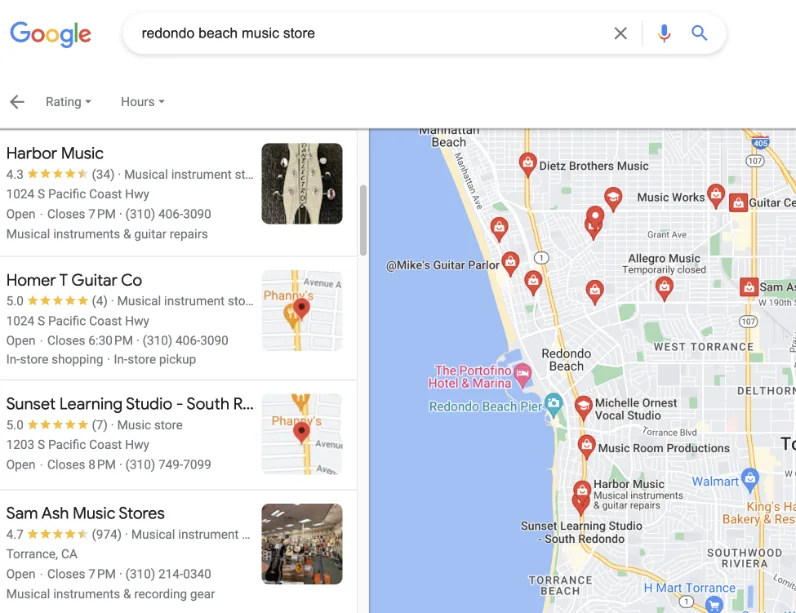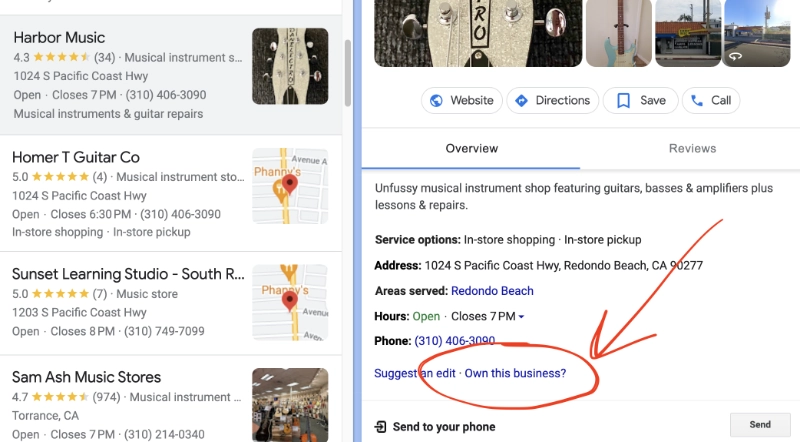How to Rank Locally on Google Quickly
Updated on April 16, 2023 by Tim Donahue
Learn How to Rank Locally on Google Quickly – In Just 5 Steps
The goal of this article is to help you rank locally on Google quickly by providing 5 essential steps to follow. Local SEO is important for small businesses that want to target customers in their area. In this article, we’ll cover the steps you need to take to achieve local search success.
Step 1: Optimize Your Google My Business Listing:
Claim it, verify it, add photos and business info
Google My Business (GMB) is a free tool that allows you to manage your online presence on Google Search and Maps. Optimizing your GMB listing is essential for improving your local SEO performance.
Here’s an example of Google Local Search. You get this screen when you type a local city or area, and a type of business like “music store” or “restaurant” etc.

Exactly How You Can Get Started With This Step:
- Create or claim your Google My Business listing: Go to the Google My Business website and sign in with your Google account. Follow the instructions to create or claim your listing. See the circled red area below – that’s where you click to claim your business.

- Verify your business information: Google will send a postcard with a verification code to your business address. Enter the code in your GMB dashboard to complete the verification process.
- Add accurate business details: Make sure your business name, address, phone number, website, and hours of operation are correct. Update this information whenever changes occur.
- Include photos and videos: Add high-quality images and videos that showcase your products, services, and location. This helps potential customers get a better understanding of your business.
- Encourage customer reviews: Reviews play a crucial role in local SEO. Ask your satisfied customers to leave a review on your GMB listing, and make sure to respond to all reviews, both positive and negative.
Step 2: Optimize Your Website for Local SEO
Once your GMB listing is optimized, it’s time to focus on your website. Ensuring that your site is optimized for local SEO will help improve its visibility in local search results.
Exactly How You Can Get Started With This Step:
- Use local keywords: Research keywords that are relevant to your business and location. Use these keywords in your website content, title tags, and meta descriptions. You can use tools like Google Ads Keyword Planner or Ahrefs Keywords Explorer for keyword research.
- Include NAP information: Display your business’s Name, Address, and Phone Number (NAP) consistently on every page of your website. This helps search engines associate your website with your GMB listing.
- Create localized content: Write blog posts and articles that are relevant to your local audience. This can include tips for your community, local events, and news updates.
- Utilize schema markup: Implement schema markup to provide search engines with more information about your business, such as your address, phone number, and opening hours. This can improve your local search rankings and enhance your search result appearance.
Step 3: Build Local Citations
Local citations are mentions of your business’s NAP (Name, Address, and Phone Number) information on other websites. Building local citations can improve your local SEO performance by increasing your online visibility and credibility.
Exactly How You Can Get Started With This
Step:
- Identify local citation sources: Look for local directories, review websites, and industry-specific platforms to list your business on. Some popular citation sources include Yelp, Yellow Pages, and TripAdvisor.
- Keep NAP information consistent: Ensure that your NAP (Name, Address, and Phone Number)information is accurate and consistent across all citation sources. Inconsistencies can confuse search engines and hurt your local SEO performance.
- Monitor and update citations: Regularly check your citation sources to ensure that your information is up-to-date. Update your listings if there are any changes to your NAP information, business hours, or services offered.
- Respond to customer reviews: Engage with your customers by responding to their reviews on citation platforms. This helps build trust and shows that you value their feedback.
Step 4: Earn Local Backlinks
Backlinks from local websites can boost your local SEO performance by signaling to search engines that your business is relevant and authoritative in your area.
Exactly How You Can Get Started With This Step:
- Network with local businesses: Connect with other businesses in your area and explore opportunities for collaboration, guest posting, or event sponsorship. These activities can help you earn local backlinks and increase your online visibility.
- Join local associations: Become a member of local business associations, chambers of commerce, or industry groups. These organizations often list their members on their websites, providing valuable local backlinks.
- Participate in local events: Sponsor or participate in local events, such as charity runs or community fairs. Event organizers often list their sponsors and participants on their websites, giving you a local backlink.
- Create valuable local content: Publish high-quality, locally-focused content on your blog that other websites may want to link to. This could include local guides, event coverage, or expert interviews.
Step 5: Monitor and Measure Your Local SEO Performance
It’s essential to regularly monitor and measure your local SEO performance to identify areas for improvement and track your progress over time.
Exactly How You Can Get Started With This Step:
- Use Google Analytics: Set up Google Analytics on your website to track metrics such as organic traffic, bounce rate, and conversion rates. Pay special attention to local traffic sources and trends.
- Monitor Google My Business Insights: Review your GMB Insights to analyze how users are interacting with your listing, such as the number of views, clicks, and phone calls.
- Track keyword rankings: Use tools like Ahrefs Rank Tracker or SEMrush to monitor your local keyword rankings and identify areas for improvement.
- Conduct regular SEO audits: Perform regular SEO audits to identify any technical issues, content gaps, or link-building opportunities that can improve your local SEO performance.
Top Tips for How to Rank Locally on Google In 5 Steps
- Focus on optimizing your Google My Business listing for better local visibility.
- Include local keywords and NAP information consistently across your website.
- Build local citations to increase your online presence and credibility.
- Earn local backlinks through networking, local associations, and valuable content.
- Regularly monitor and measure your local SEO performance using tools like Google Analytics and keyword rank trackers.
Steps You Can Take To Get Started
- Claim and optimize your Google My Business listing.
- Perform keyword research to identify relevant local keywords for your website.
- Update your website with local keywords, NAP information, and localized content.
- Identify local citation sources and build consistent citations for your business.
- Connect with local businesses and associations to earn local backlinks.
- Monitor your local SEO performance using Google Analytics and other tools.
In Summary: The Key Concepts
Now that you’ve learned the essential steps to rank locally on Google, it’s time to take action.
Remember to focus on optimizing your Google My Business listing, incorporating local keywords and NAP information on your website, building local citations, earning local backlinks, and monitoring your local SEO performance.
By following these steps and leveraging the top tips and actionable advice provided, you’ll be well on your way to achieving local search success and attracting more customers to your business.

Tim Donahue
StartABusiness.Center
Updated on April 16, 2023